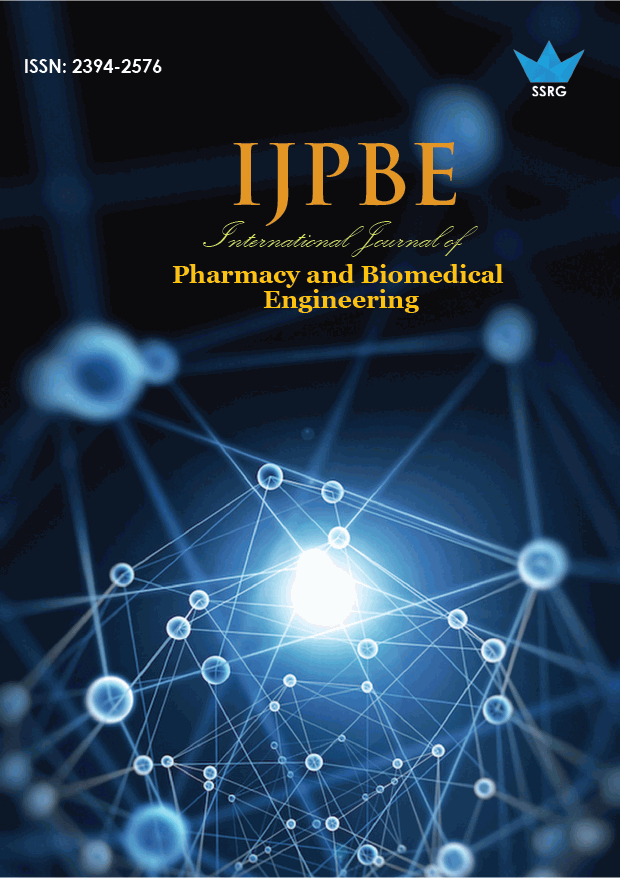Adding Flavors to the pediatric tablets and Antibiotics without minimizing its medical action

| International Journal of Pharmacy and Biomedical Engineering |
| © 2014 by SSRG - IJPBE Journal |
| Volume 1 Issue 1 |
| Year of Publication : 2014 |
| Authors : L.Ragunathan and Dr.A.Sureshkumar |
How to Cite?
L.Ragunathan and Dr.A.Sureshkumar, "Adding Flavors to the pediatric tablets and Antibiotics without minimizing its medical action," SSRG International Journal of Pharmacy and Biomedical Engineering, vol. 1, no. 1, pp. 7-9, 2014. Crossref, https://doi.org/10.14445/23942576/IJPBE-V1I1P103
Abstract:
The taking of tablets and capsules is more irritating because of its taste or flavor; generally, medications are more bitter. The tablets' taste or flavor depends on the ingredients of the tablets, such as the chemical contents of the tablets and capsules. With the palatability formulation improvements, the taste of tablets and capsules can change without changes in its ingredients and actions. This method provides effective medication reach ability to the children and some hated by the medications. The flavors are used to compress the bitter taste of the tablets and capsules. This approach aims to increase the effective medication for the children and some people who hate medicines.
Keywords:
Taste masking, Taste receptors, palatability formulation, palatability antibiotics
References:
[1] http://grants.nih.gov/. Gives articles made on to develop bitter blockers based on the biology of taste
[2] BPCA/Pharm Branch/NICHD PFI Working Meeting December 6–7, 2005 04-09-06. Best Pharmaceuticals for Children Act (BPCA) Pediatric Formulation Initiative (PFI) Working Meeting December 6–7, 2005 Bethesda, MD, page no 14
[3] BPCA/OPPB/NICHD PFI Workshop November 1–2, 2011 Final 12-27-11, pg no 18.
[4] http://www.suite101.com/article.cfm/, the human tongue anatomy cited on 15 September2011.
[5] www.fda.com gives the amendments made in-laws.
[6] Sharma S and S. Lewis, 2010. “Taste Masking Technologies: a review”. Int J. Pharmacy and Pharmaceutical Sci, 2(2): 6-13.
[7] Pebley WS, Jager NE, Thompson SJ. Rapidly disintegrating tablet. US Patent 5, 298, 261. 1994 March 29.
[8] Watanabe Y. “New compressed tablet rapidly disintegrating in the mouth using crystalline cellulose and a disintegrant”. Biol Pharm Bull. 1995; 18: 1308–1310. PMid:8845832
[9] Myers GL, Battist GE, Fuisz RC. “Process and apparatus for making rapidly dissolving dosage units and product there from”. PCT Patent WO 95/34293-A1.1995 Dec 21.
[10] Allen LV, Wang B. “Process for making a particulate support matrix for making a rapidly dissolving tablet”. US Patent 5,587,180. 1996 Dec 24. Mouth Dissolving Tablets II: An Overview of Evaluation Techniques 339 Sci Pharm. 2009; 77; 327–341.
[11] Hill EM, Flaitz CM, Frost GR: “Sweetener content of common pediatric oral liquid medications”. American Journal of Hospital Pharmacy 1988; 45:135-42.
[12] Dawson LM, Nahata MC. “Guidelines for compounding oral medications for pediatric patients”. Journal of Pharmacy Technology 1991; Vol. Sept./Oct.: 168-175.
[13] Pawar S, Kumar A. “Issues in the formulation of drugs for oral use in children”. Pediatric Drugs 2002; 4: 371-379.

 10.14445/23942576/IJPBE-V1I1P103
10.14445/23942576/IJPBE-V1I1P103